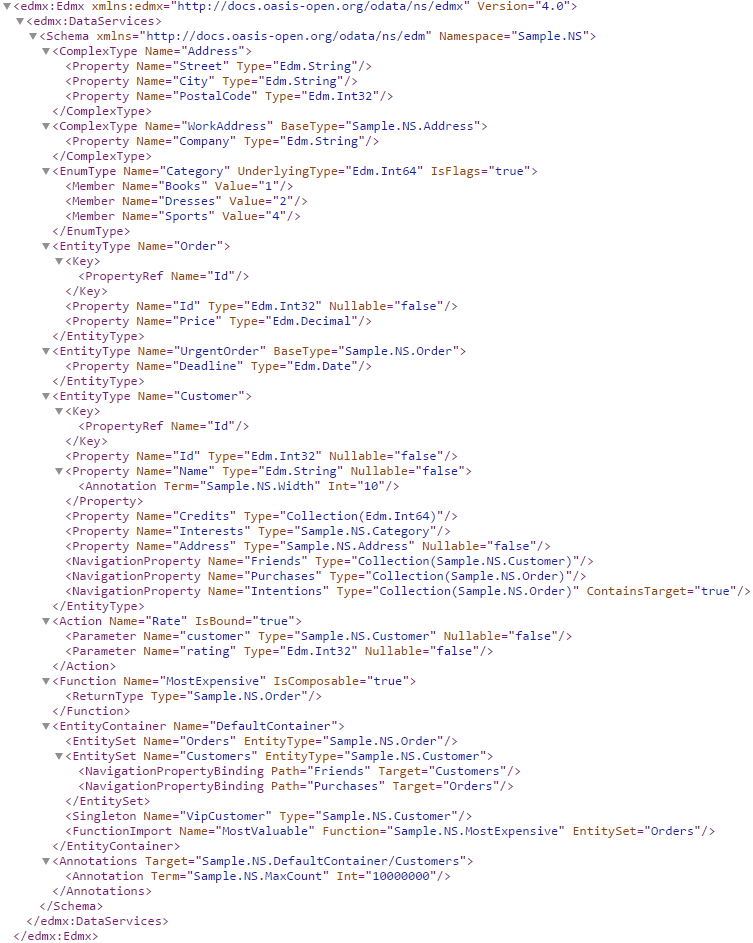Define annotations(ODL V6.x)
Applies To: # OData Core lib v6 supported OData Core Lib V6
OData Core Lib V6
EdmLib supports adding annotations on various model elements, including entity sets, entity types, properties and so on. Annotations can be put under the Annotations element in the schema as well as the targetted model elements (inline annotations). Users can specify the serialization location using EdmLib API.
This section shows how to define annotations using EdmLib APIs. We will continue to use and extend the sample from the previous sections.
Add an Annotation to the Entity Set Customers
In the SampleModelBuilder.cs file, add the following using clause:
using Microsoft.OData.Edm.Csdl;
using Microsoft.OData.Edm.Library.Annotations;
using Microsoft.OData.Edm.Values;
Then add the following code into the SampleModelBuilder class:
namespace EdmLibSample
{
public class SampleModelBuilder
{
...
public SampleModelBuilder BuildAnnotations()
{
var term1 = new EdmTerm("Sample.NS", "MaxCount", EdmCoreModel.Instance.GetInt32(true));
var annotation1 = new EdmAnnotation(_customerSet, term1, new EdmIntegerConstant(10000000L));
_model.AddVocabularyAnnotation(annotation1);
return this;
}
...
}
}
And in the Program.cs file, insert the following code into the Main method:
namespace EdmLibSample
{
class Program
{
public static void Main(string[] args)
{
var builder = new SampleModelBuilder();
var model = builder
...
.BuildMostValuableFunctionImport()
#region !!!INSERT THE CODE BELOW!!!
.BuildAnnotations()
#endregion
.GetModel();
WriteModelToCsdl(model, "csdl.xml");
}
}
}
This code adds an Edm.Int32 annotation Sample.NS.MaxCount targetting the entity set Customers to the Annotations element.
Add an Inline Annotation to the Entity Type Customer
In the SampleModelBuilder.cs file, insert the following code into the SampleModelBuilder.BuildAnnotations() method:
namespace EdmLibSample
{
public class SampleModelBuilder
{
...
public SampleModelBuilder BuildAnnotations()
{
...
_model.AddVocabularyAnnotation(annotation1);
#region !!!INSERT THE CODE BELOW!!!
var term2 = new EdmTerm("Sample.NS", "KeyName", EdmCoreModel.Instance.GetString(true));
var annotation2 = new EdmAnnotation(_customerType, term2, new EdmStringConstant("Id"));
annotation2.SetSerializationLocation(_model, EdmVocabularyAnnotationSerializationLocation.Inline);
_model.AddVocabularyAnnotation(annotation2);
#endregion
return this;
}
...
}
}
This code adds an inline Edm.String annotation Sample.NS.KeyName targetting the entity type Customer.
Add an Inline Annotation to the Property Customer.Name
In the SampleModelBuilder.cs file, insert the following code into the SampleModelBuilder.BuildAnnotations() method:
namespace EdmLibSample
{
public class SampleModelBuilder
{
...
public SampleModelBuilder BuildAnnotations()
{
...
_model.AddVocabularyAnnotation(annotation2);
#region !!!INSERT THE CODE BELOW!!!
var term3 = new EdmTerm("Sample.NS", "Width", EdmCoreModel.Instance.GetInt32(true));
var annotation3 = new EdmAnnotation(_customerType.FindProperty("Name"), term3, new EdmIntegerConstant(10L));
annotation3.SetSerializationLocation(_model, EdmVocabularyAnnotationSerializationLocation.Inline);
_model.AddVocabularyAnnotation(annotation3);
#endregion
return this;
}
...
}
}
This code adds an inline Edm.Int32 annotation Sample.NS.Width targetting the property Customer.Name.
Run the Sample
Build and run the sample. Then open the csdl.xml file under the output directory. The content of csdl.xml should look like the following:

Feedback
Coming soon: Throughout 2024 we will be phasing out GitHub Issues as the feedback mechanism for content and replacing it with a new feedback system. For more information see: https://aka.ms/ContentUserFeedback.
Submit and view feedback for